I have been successful turning wet cherry NE to 1/4” thickness without cracking, but would like to leave thicker. I have several wet cherry blanks 14-16” and want to turn to at least 3/8” thickness. I do have a kiln. So what should I expect asa success rate?
-
May 2025 Turning Challenge: Long Neck Hollowform! (click here for details) -
Congratulations to Phil Hamel winner of the April 2025 Turning Challenge (click here for details) -
Congratulations to Maggie Shapiro for "My 2nd Basket Illusion" being selected as Turning of the Week for 26 May, 2025 (click here for details) -
Welcome new registering member. Your username must be your real First and Last name (for example: John Doe). "Screen names" and "handles" are not allowed and your registration will be deleted if you don't use your real name. Also, do not use all caps nor all lower case.
You are using an out of date browser. It may not display this or other websites correctly.
You should upgrade or use an alternative browser.
You should upgrade or use an alternative browser.
How thick can you leave a once turned NE bowl?
- Thread starter William Rogers
- Start date
- Joined
- Apr 27, 2004
- Messages
- 9,194
- Likes
- 5,819
- Location
- Lakeland, Florida
- Website
- www.hockenberywoodturning.com
So what should I expect asa success rate?
Put your 3/8” bowl in paper bags for a few weeks to slow the drying.
With a nice curve, an even wall thickness, & slow drying - Expect 100% success
Assuming no pre-existing cracks, no pith in, a nice behaving cherry you should be fine.
If you are fan of Tony Hillerman - Seldom Disappointed- - expect 0% success to avoid disappointments.
One note on cherry a bunch of good turners in our club got a rogue cherry that was about 3 ft in diameter.
It had a 3” sap ring. We compared notes and just about everybody had several roughed out bowls crack.
One of mine went super oval.
This one bizarre cherry tree is an exception to I wood I have found easy to dry.
The risk of cracking will be some what higher with a thicker walled bowl. The paper bag method will help slow things down. Best paper bag method I heard of was from Christian Burshard who does strange things with Madrone. He puts the piece in a paper bag, and then puts that in a plastic bag. Change out the paper bag every day. I love madrone because of how it warps as it dries. Spring harvested trees seem to have much less cracking than summer or fall harvested trees. I would not use any type of kiln. One reason is that the bowl can be pretty much totally dry in about a week. The other is that any type of acceleration of the drying process can cause cracking, especially if there are any uneven thickness spots anywhere on the bowl. Some times you can wet sand and put on finish which really helps even out the drying process. With the madrone, I won't do 3/8 thick bowls because crack rate is much higher. No problem with big leaf maple. Unfortunately I don't get much black cherry out here in Oregon.... I think it is more crack prone if you once turn it.
robo hippy
robo hippy
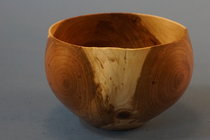
This bowl is not NE but it does show the distortion at about 6" dia. x 4" high x 1/8th" wall that will occur in black cherry especially with the 3 piths of a crotch and the smaller knot. The piths although it does not show in the photo have dimpled so any thicker wall would definitely result in major cracks.
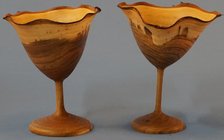
These two goblet forms in black cherry at about 4" dia x 5" high x 1/32" wall thickness clearly show the difference in shrinkage rate between the bark and the wood.
The other thing to consider is how long it is since the tree was live and healthy and of course the best way to keep the bark attached is to cut the tree live and healthy in it's dormant stage and turn it without allowing it to begin drying. Note: if the bark requires CA to keep it attached as far as I'm concerned it is too late for a bark natural edge.
As Hockenbery says, and I have experienced, lower expectations will lead to a happy life. Your odds of cracking go down with blanks harvested in the fall and winter since the sap is down and the sapwood will shrink a little less. Staying further away from the pith will also help. If your blanks are already cut, stop wasting time and get to turning. Many drying cracks start to form before the wood ever hits the lathe. You don't want to throw thicker bowls directly into a kiln. Maybe a freezer will help more.
For once turned bowls, you can leave the wood pretty thick, you have to start with defect free blanks and turn it before it starts splitting, and then dry it slowly, I mean SLOWLY.
I've been using the brown paper bag for years and years, I have hardly ever a split, even knots can dry without splits, though it is harder with thicker wood, case in point, here is a large Black Walnut that I rough turned in 2005.
As I had gotten so much Black Walnut that I just rough turned everything as quickly as possibly, so here it sits now waiting to be returned, I just did one a couple weeks ago that was better than 1 inch thick, worked just fine.
Shown right below.
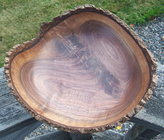
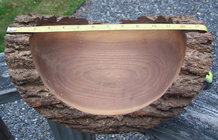
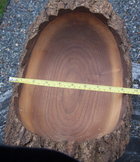
I've been using the brown paper bag for years and years, I have hardly ever a split, even knots can dry without splits, though it is harder with thicker wood, case in point, here is a large Black Walnut that I rough turned in 2005.
As I had gotten so much Black Walnut that I just rough turned everything as quickly as possibly, so here it sits now waiting to be returned, I just did one a couple weeks ago that was better than 1 inch thick, worked just fine.
Shown right below.



Last edited:
Leo I am getting 2 trees of black walnut cut from a neighbour next week. Never turned black walnut before. I am thinking of cutting logs 4 feet long, diameter is about 16 to 18 inches. Will pile them outside and tarp them and keep them off ground. As for turning, would you rough them out at 10% of diameter and just bag them in leaf bags( Canadian Tire). I have a heated crawl space I store them in for the year. Does this sound like a good process? I bought end cut sealer from Woodchuckers cheaper than Anchorseal. I will not use any sealer and just bag them? Thanks for the info Leo. Your work looks amazing.
Are you able to get wood to dry in a week using Christian’s paper/plastic bag method? Can you explain with more detail? Does that only work for certain types of woods at at specific wall thickness? I would love to give it a try.I would not use any type of kiln. One reason is that the bowl can be pretty much totally dry in about a week.
I cored a few white oak bowls 6 weeks ago and covered them with anchor seal. I left the wall thickness at 10% and they are holding up ok. I am storing them in the garage and Seattle is pretty humid. I see a couple of minor surface cracks but hoping they disappear once I finish them them next year. None of them seem to be warping very much.
I tried single turning one of the other logs from the same tree and ended up with 1/4” wall thickness all around. It still was a little wet, but didn’t need much sanding so I went to 320 and finished it with Doctor’s walnut oil microcrystal paste wax the same day. It has been sitting inside the house for 5 days and hasn’t moved much or cracked at all (yet). That is usually not the case with green walnut or maple so I am keeping my fingers crossed about the oak.
- Joined
- Apr 27, 2004
- Messages
- 9,194
- Likes
- 5,819
- Location
- Lakeland, Florida
- Website
- www.hockenberywoodturning.com
Will pile them outside and tarp them and keep them off ground. As for turning, would you rough them out at 10% of diameter and just bag them in leaf bags( Canadian Tire).
If you want the white sapwood turn it soon. There is no right or wrong. There is too long - the sap wood will get punky.
White sapwood 13” diameter
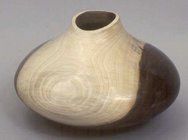
Discolored sapwood 9” diameter
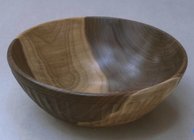
- Joined
- Feb 28, 2021
- Messages
- 1,604
- Likes
- 1,405
- Location
- Roulette, PA
- Website
- www.reallyruralwoodworks.com
I'll second that. Probably a quarter of a face cord worth of firewood now because I let it sit out too long without processing... Most of it was larger size branch wood, so it was about 50% to 60% sapwood - It was only the larger pieces with enough heartwood to make stuff with that ended up being usable, and even then the bugs/worms seemed to love the walnut, all the way through sapwood, but they seemed to turn aside when they hit heartwood.. (as well as Maple and Apple that had been left out , but those pieces were all scrap anyhow..) I presume because the wood tended to have higher sugar content (You can make some pretty good syrup from Black Walnut sap, just like you can with Maple..) Also Apple wood (I had some smaller branches set aside I forgot about) will also very quickly go punky like the Walnut sapwood will. (They sat out under cover and off the ground for a little over 2 years before I started digging into that pile, and now my walnut stash is about half as big as it was a couple months ago.. so yes, like Hockenberry said, there is "too long" as a possibility..)There is too long - the sap wood will get punky.
Norm get the wood and turn it right away, no storing, especially not in a warm/heated place, rough at 10% is OK, I always use the brown paper bags, I'm not sure but some of those leaf bags have several layer and prevent the absorbed moisture to evaporate.Leo I am getting 2 trees of black walnut cut from a neighbour next week. Never turned black walnut before. I am thinking of cutting logs 4 feet long, diameter is about 16 to 18 inches. Will pile them outside and tarp them and keep them off ground. As for turning, would you rough them out at 10% of diameter and just bag them in leaf bags( Canadian Tire). I have a heated crawl space I store them in for the year. Does this sound like a good process? I bought end cut sealer from Woodchuckers cheaper than Anchorseal. I will not use any sealer and just bag them? Thanks for the info Leo. Your work looks amazing.
So don't wait and do our store in a warm place, a cool place is what you want to have a slow drying environment, no sealer use if packed in brown paper bag.
Sealer is good for the just cut logs and only for a few days if stored out of the sun and up from the ground, quick processing is the best you can do.
Here is what you can do with slow drying, not 100% guaranteed, but mostly this can be done if you like to dry the pieces with knots in it.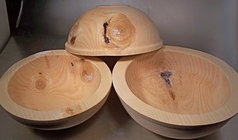
You can also try quick drying for tis effect, Black Walnut Sapwood will stand this usually if turned thin, but don't be surprised if you get splits.
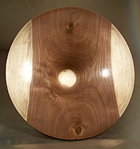
This one here is dry in this picture, and as I kept it I noticed that the white color did still change to a darker tone after a couple of years.

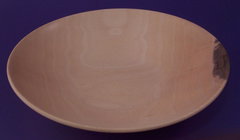

You can also try quick drying for tis effect, Black Walnut Sapwood will stand this usually if turned thin, but don't be surprised if you get splits.

This one here is dry in this picture, and as I kept it I noticed that the white color did still change to a darker tone after a couple of years.


I never tried the plastic/paper bag method, mostly due to the volume I used to do. Christian likes to fold and mold his pieces to all sorts of different shapes. For me, I take the finish turned bowl and start it drying on the floor. It stays there for a day or a week if I remember. It goes up on a wire rack shelf after that. They have pretty much stopped moving after a week, which means I can then sand them. You do need a lathe that will go down to 10 or so rpm. The old 3520A would do that. The Vicmark lathes do that as well. I had my Robust programmed to run that slow. Above 15 or so rpm, you can't keep the abrasives on the wood as it spins. I did make an articulated arm for sanding, and have a video about that. It allows me to hold the drill with only one hand, which means the other hand is able to spin the bowl by hand. I find that particularly handy for the first grits. I did try wet sanding while the bowl was fresh turned, and it seemed to take longer and made a mess, plus, the sludge would plug and hide some tear out, so I gave up on that method.
robo hippy
robo hippy
